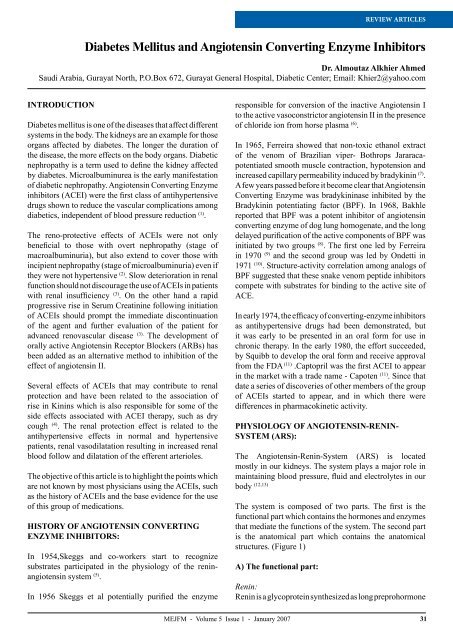Contents - Middle East Journal of Family Medicine
Contents - Middle East Journal of Family Medicine
Contents - Middle East Journal of Family Medicine
You also want an ePaper? Increase the reach of your titles
YUMPU automatically turns print PDFs into web optimized ePapers that Google loves.
REVIEW ARTICLESDiabetes Mellitus and Angiotensin Converting Enzyme InhibitorsDr. Almoutaz Alkhier AhmedSaudi Arabia, Gurayat North, P.O.Box 672, Gurayat General Hospital, Diabetic Center; Email: Khier2@yahoo.comINTRODUCTIONDiabetes mellitus is one <strong>of</strong> the diseases that affect differentsystems in the body. The kidneys are an example for thoseorgans affected by diabetes. The longer the duration <strong>of</strong>the disease, the more effects on the body organs. Diabeticnephropathy is a term used to define the kidney affectedby diabetes. Microalbuminurea is the early manifestation<strong>of</strong> diabetic nephropathy. Angiotensin Converting Enzymeinhibitors (ACEI) were the first class <strong>of</strong> antihypertensivedrugs shown to reduce the vascular complications amongdiabetics, independent <strong>of</strong> blood pressure reduction (1) .The reno-protective effects <strong>of</strong> ACEIs were not onlybeneficial to those with overt nephropathy (stage <strong>of</strong>macroalbuminuria), but also extend to cover those withincipient nephropathy (stage <strong>of</strong> microalbuminuria) even ifthey were not hypertensive (2) . Slow deterioration in renalfunction should not discourage the use <strong>of</strong> ACEIs in patientswith renal insufficiency (3) . On the other hand a rapidprogressive rise in Serum Creatinine following initiation<strong>of</strong> ACEIs should prompt the immediate discontinuation<strong>of</strong> the agent and further evaluation <strong>of</strong> the patient foradvanced renovascular disease (3). The development <strong>of</strong>orally active Angiotensin Receptor Blockers (ARBs) hasbeen added as an alternative method to inhibition <strong>of</strong> theeffect <strong>of</strong> angiotensin II.Several effects <strong>of</strong> ACEIs that may contribute to renalprotection and have been related to the association <strong>of</strong>rise in Kinins which is also responsible for some <strong>of</strong> theside effects associated with ACEI therapy, such as drycough (4) . The renal protection effect is related to theantihypertensive effects in normal and hypertensivepatients, renal vasodilatation resulting in increased renalblood follow and dilatation <strong>of</strong> the efferent arterioles.The objective <strong>of</strong> this article is to highlight the points whichare not known by most physicians using the ACEIs, suchas the history <strong>of</strong> ACEIs and the base evidence for the use<strong>of</strong> this group <strong>of</strong> medications.HISTORY OF ANGIOTENSIN CONVERTINGENZYME INHIBITORS:In 1954,Skeggs and co-workers start to recognizesubstrates participated in the physiology <strong>of</strong> the reninangiotensinsystem (5) .In 1956 Skeggs et al potentially purified the enzymeresponsible for conversion <strong>of</strong> the inactive Angiotensin Ito the active vasoconstrictor angiotensin II in the presence<strong>of</strong> chloride ion from horse plasma (6) .In 1965, Ferreira showed that non-toxic ethanol extract<strong>of</strong> the venom <strong>of</strong> Brazilian viper- Bothrops Jararacapotentiatedsmooth muscle contraction, hypotension andincreased capillary permeability induced by bradykinin (7) .A few years passed before it become clear that AngiotensinConverting Enzyme was bradykininase inhibited by theBradykinin potentiating factor (BPF). In 1968, Bakhlereported that BPF was a potent inhibitor <strong>of</strong> angiotensinconverting enzyme <strong>of</strong> dog lung homogenate, and the longdelayed purification <strong>of</strong> the active components <strong>of</strong> BPF wasinitiated by two groups (8) . The first one led by Ferreirain 1970 (9) and the second group was led by Ondetti in1971 (10) . Structure-activity correlation among analogs <strong>of</strong>BPF suggested that these snake venom peptide inhibitorscompete with substrates for binding to the active site <strong>of</strong>ACE.In early 1974, the efficacy <strong>of</strong> converting-enzyme inhibitorsas antihypertensive drugs had been demonstrated, butit was early to be presented in an oral form for use inchronic therapy. In the early 1980, the effort succeeded,by Squibb to develop the oral form and receive approvalfrom the FDA (11) .Captopril was the first ACEI to appearin the market with a trade name - Capoten (11) . Since thatdate a series <strong>of</strong> discoveries <strong>of</strong> other members <strong>of</strong> the group<strong>of</strong> ACEIs started to appear, and in which there weredifferences in pharmacokinetic activity.PHYSIOLOGY OF ANGIOTENSIN-RENIN-SYSTEM (ARS):The Angiotensin-Renin-System (ARS) is locatedmostly in our kidneys. The system plays a major role inmaintaining blood pressure, fluid and electrolytes in ourbody (12,13)The system is composed <strong>of</strong> two parts. The first is thefunctional part which contains the hormones and enzymesthat mediate the functions <strong>of</strong> the system. The second partis the anatomical part which contains the anatomicalstructures. (Figure 1)A) The functional part:Renin:Renin is a glycoprotein synthesized as long preprohormoneMEJFM - Volume 5 Issue 1 - January 2007 31
















